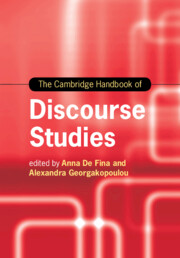Book contents
- The Cambridge Handbook of Discourse Studies
- Cambridge Handbooks in Language and Linguistics
- The Cambridge Handbook of Discourse Studies
- Copyright page
- Contents
- Figures
- Tables
- Contributors
- Preface
- Part I (Con)Textualizing Discourses
- Part II Perspectives and Modes of Analysis
- 6 Sequence Organization: Understanding What Drives Talk
- 7 Doing Micro-Analysis of Discourse: The Case of Ageing and Wellbeing
- 8 Corpus-Assisted Discourse Studies
- 9 Cognitive Linguistic and Experimental Methods in Critical Discourse Studies
- 10 Metaphor, Metonymy and Framing in Discourse
- 11 Poststructuralist Discourse Studies: From Structure to Practice
- Part III Discourse Materialities and Embodiment
- Part IV (Trans)Locations and Intersections
- Part V Ethics, Inequality and Inclusion
- Part VI Discourses, Publics and Mediatization
- Index
- References
6 - Sequence Organization: Understanding What Drives Talk
from Part II - Perspectives and Modes of Analysis
Published online by Cambridge University Press: 28 September 2020
- The Cambridge Handbook of Discourse Studies
- Cambridge Handbooks in Language and Linguistics
- The Cambridge Handbook of Discourse Studies
- Copyright page
- Contents
- Figures
- Tables
- Contributors
- Preface
- Part I (Con)Textualizing Discourses
- Part II Perspectives and Modes of Analysis
- 6 Sequence Organization: Understanding What Drives Talk
- 7 Doing Micro-Analysis of Discourse: The Case of Ageing and Wellbeing
- 8 Corpus-Assisted Discourse Studies
- 9 Cognitive Linguistic and Experimental Methods in Critical Discourse Studies
- 10 Metaphor, Metonymy and Framing in Discourse
- 11 Poststructuralist Discourse Studies: From Structure to Practice
- Part III Discourse Materialities and Embodiment
- Part IV (Trans)Locations and Intersections
- Part V Ethics, Inequality and Inclusion
- Part VI Discourses, Publics and Mediatization
- Index
- References
Summary
Sequence organization was the pioneering insight that gave rise to conversation analysis (CA) and it remains the primary assumption in CA studies about how discourse is structured and how speakers manage their talk. In order to study discourse in an empirically grounded way, we must demonstrate how our analysis reflects the participants’ understanding of their own talk. CA does this through the concept of “response relevance.” When a speaker talks, they make relevant some “next” response, so speakers are always responding to some prior turn and simultaneously making relevant a next turn. In this way, participants demonstrate their understandings of prior talk while responding. These demonstrations form the basis of the “next turn proof procedure,” which is how CA uses participants’ responses as demonstrations of participants’ own analyses of prior talk. In this chapter, I explain how CA’s focus on sequence and “next” turns allows for an empirical understanding of how discourse is organized. I first outline the principles of sequence organization, starting with the concept of response relevance and adjacency pairs, before explaining pre-, insert and post-expansion components. Next, I review sequence research from the past four decades, highlighting the focus on specific sequences such as pre-sequences, storytelling and the effect of institutional contexts. More recent streams in sequence research include the investigation of “lapses” or discontinuities in interaction, the attempts to describe overall sequence structures of full (typically institutional) encounters, the focus on temporality, and investigations of closing sequences. Finally, I discuss the (sometimes uncritical) use of the words “activity” and “project” in CA research, and what evidence is presented for its effect on sequence.
Keywords
- Type
- Chapter
- Information
- The Cambridge Handbook of Discourse Studies , pp. 121 - 142Publisher: Cambridge University PressPrint publication year: 2020
References
Further Reading
This volume has an excellent collection of different ways in which multiactivity can appear in various contexts and with various practices.
This book covers many of the “stages” found in medical consultations (diagnosis, treatment, etc.) and, as such, provides examples of how full interactions may be broken down into activity units.
This is the primary resource for the details of sequential organization.
References
- 1
- Cited by



